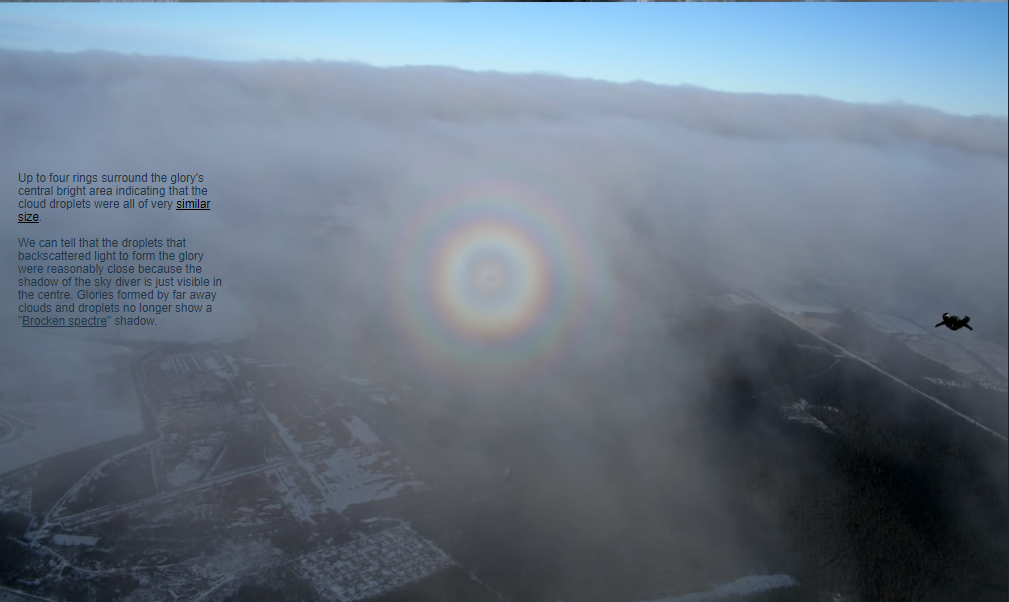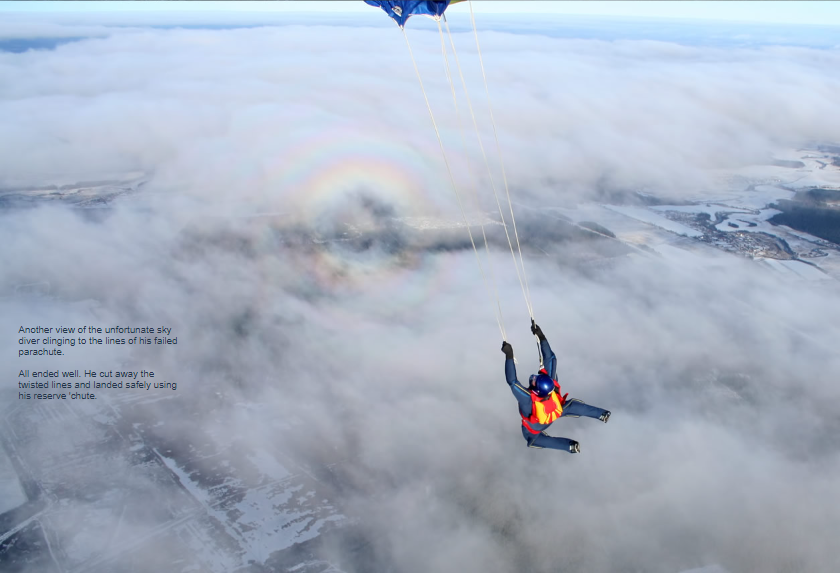OPOD - Failed Parachute & Glory
Failed 'Chute & Glory: A Captivating Phenomenon in the Sky
Have you ever wondered what happens when a parachute fails to open? While searching for a glory might not be the first thing on your mind, the sky can sometimes surprise us with unexpected wonders. In this article, we will explore the captivating atmospheric optics phenomenon known as the "Failed 'Chute & Glory." Let's delve into the details and unravel the science behind this mesmerizing sight.
The Enigmatic Multi-Ringed Glory
In Russia, photographer Mikhail Ivanov captured remarkable images of an unusual event in the sky. Water droplets present in a thin cloud closer to the ground diffracted light, giving rise to a multi-ringed glory at the top center-left of the photographs. These concentric rings of light create a mesmerizing display against the backdrop of the sky.
Indicators of Droplet Size and Distance
The number of rings surrounding the central bright area of the glory can provide valuable insights into the properties of the cloud droplets involved. In this case, up to four rings were visible, indicating that the droplets responsible for backscattering light and forming the glory were all of similar size. This similarity in droplet size contributes to the distinctness of the concentric rings.
Moreover, an intriguing observation can be made from the photographs. The faint shadow of a skydiver can be seen at the center of the glory. This shadow suggests that the droplets responsible for the glory were relatively close to the observer. In contrast, when glories form from faraway clouds and droplets, a phenomenon known as a "Brocken spectre" shadow is no longer visible.
The Perilous Adventure: A Skydiver's Triumph
In addition to the stunning atmospheric optics display, the photographs also capture an unfortunate skydiver in distress. Clinging to the tangled lines of his failed parachute, he found himself in a precarious situation. However, all ended well as he swiftly cut away the twisted lines and safely descended using his reserve parachute.
Understanding the Glory Phenomenon
The glory phenomenon occurs when sunlight interacts with water droplets in the atmosphere. As sunlight passes through these tiny droplets, it undergoes diffraction, resulting in the formation of concentric rings of light. The size and uniformity of the droplets play a crucial role in determining the distinctness and number of rings observed in a glory.
Glories are commonly observed when a light source, such as the sun, is positioned behind an observer who is surrounded by a cloud or fog composed of uniformly sized droplets. The precise conditions required for a glory to form make it a relatively rare phenomenon to witness.
Exploring the Optical Illusion
The Failed 'Chute & Glory serves as a reminder of the captivating and diverse optical illusions that can occur in our atmosphere. From the refraction and diffraction of light to the scattering of sunlight by tiny droplets, the interplay of these optical phenomena can create breathtaking displays for those fortunate enough to witness them.
Conclusion
The Failed 'Chute & Glory phenomenon showcases the awe-inspiring beauty of atmospheric optics. Through the lens of Mikhail Ivanov's camera, we catch a glimpse of the multi-ringed glory formed by diffracted light interacting with water droplets in a thin cloud. Furthermore, we observe the shadow of a skydiver, providing insights into the size and proximity of the droplets involved.
As we explore the wonders of our atmosphere, we are reminded of the extraordinary phenomena that can occur when light interacts with the natural elements around us. The Failed 'Chute & Glory serves as a testament to the mesmerizing and unpredictable nature of atmospheric optics, leaving us in awe of the beauty that surrounds us every day.

Failed 'Chute & Glory
When your parachute fails to open, searching for a glory is not of the highest priority.
Images taken over Russia by Mikhail Ivanov. Water droplets in the lower thin cloud diffracted light to form the multi-ringed glory at top centre-left.
More images below.
©Mikhail Ivanov, shown with permission

Up to four rings surround the glory's central bright area indicating that the cloud droplets were all of very similar size.
We can tell that the droplets that backscattered light to form the glory were reasonably close because the shadow of the sky diver is just visible in the centre. Glories formed by far away clouds and droplets no longer show a "Brocken spectre" shadow.

Another view of the unfortunate sky diver clinging to the lines of his failed parachute.
All ended well. He cut away the twisted lines and landed safely using his reserve 'chute.
Note: this article has been automatically converted from the old site and may not appear as intended. You can find the original article here.
Reference Atmospheric Optics
If you use any of the definitions, information, or data presented on Atmospheric Optics, please copy the link or reference below to properly credit us as the reference source. Thank you!
-
<a href="https://atoptics.co.uk/blog/opod-failed-parachute-glory/">OPOD - Failed Parachute & Glory</a>
-
"OPOD - Failed Parachute & Glory". Atmospheric Optics. Accessed on November 26, 2024. https://atoptics.co.uk/blog/opod-failed-parachute-glory/.
-
"OPOD - Failed Parachute & Glory". Atmospheric Optics, https://atoptics.co.uk/blog/opod-failed-parachute-glory/. Accessed 26 November, 2024
-
OPOD - Failed Parachute & Glory. Atmospheric Optics. Retrieved from https://atoptics.co.uk/blog/opod-failed-parachute-glory/.